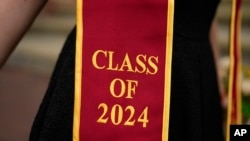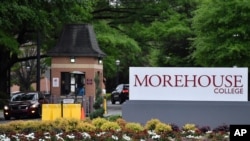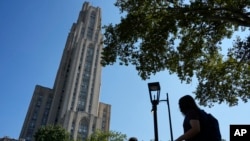Student Union
Use These Words To Get A Reply to Your Email

Student Union Quiz: Which is the best way to end your email if you really want to get a response?
A) Best
B) Thank you
C) Regards
D) Thanks in advance
You send an email and really want a reply. Can the words you choose increase your chances of getting a response?
Yes, they can.
A study on email found that you can increase your chances of getting a response you seek.
Boomerang, a company that produces apps that help manage email, conducted the study. It asked its users which factors influenced the rate of response.
It found that one factor is the length of an email. It should be short but not too short. Another factor is the tone: Is your language too informal or too formal? Are the words and grammar too simple or too advanced?
Even the length of your subject line may affect your chances of getting a response. The way you close an email can determine if you get a response. Or not.
Don’t forget the subject line
The subject line is what people will see first. Boomerang says subject lines with three to four words are the best.
The response rate goes down, they found, with each word you add. So, remember when writing your subject line -- less is more.
Write simply
Boomerang found that a third-grade level works best and gets the most responses. Use simple words in simple sentences. Do not utilize convoluted terminologies: In more simple words, don't use complex words when simple ones will work just fine.
Keep it short. (But not too short!)
Boomerang found that the “sweet spot for email length is between 50 and 125 words.” Experts say the response rate for emails of this length is above 50 percent.
But, do not write all 125 words into one long paragraph. Break them up into a couple short paragraphs. It is much easier to read this way.
Ask a question
Remember, you are trying to get a response to your email. A good way is to ask the reader a question. It gives them something to do.
Boomerang found that the emails that asked no questions had the lowest response rate. Emails that ask between one to three questions are “50 percent more likely to get a response than emails asking no questions.”
Again, don’t ask too many questions. With each extra question you ask in your email, your response rate drops.
Show some feeling. (But not too much.)
The tone of your email matters. The tone is the feeling or attitude expressed by the written or spoken words.
When writing an email, be positive, (but not too positive) or negative (but not too negative.) Being neutral -- neither positive nor negative -- gets you nowhere.
Do you think the following email is appropriate to write to a professional acquaintance or colleague?
“Hi! I haven’t seen you in so long!! I’m wondering how you are. I would very much like to see you again soon!!! Would you care to have coffee with me tomorrow afternoon?”
This email is too positive, too emotional and too formal – a strange combination. The sentences use too many personal pronouns. This adds too much feeling. It may make reader feel uncomfortable. It sounds a bit creepy!
The writer of this email also uses too many exclamation points – something you really want to avoid. Using too many exclamation points is a sure sign that your email is too positive and possibly, annoying.
Try this instead:
“Hi there! Hope you’ve been well. Let’s catch up over coffee soon. Are you free anytime next week?”
“Hope you’ve been well” is very common to include in an email to both friends and co-workers. It’s a nice thought to share. But it also has a second purpose. It says that the writer and reader haven’t seen each other recently. An English speaker will read between the lines and understand this hidden meaning.
You could also write “How’ve you been? It’s been a long time!” By simply stating that a lot of time has passed, you put the importance on time and not your feelings.
So, it’s positive but not overly emotional. The tone is casual but professional. And it won’t seem creepy to the reader.
This email also asks a direct question without pressuring the reader. They can pick a time when they are free for coffee or say that they are just too busy.
However, let’s say you have to write an email describing a negative experience and you want a response. As we have learned, the study found that it’s actually better to be negative than neutral. But try not to be too negative. If you had a bad experience at a store, write about it simply.
For example:
“During a visit to your store, I had a very bad experience. One of your employees was extremely rude. He refused to replace a broken television. How can I get my money back for the broken television or get a replacement?”
You might not get a response if you wrote something like this:
“Your store is awful!! I tried to return a broken television and your employee was rude! He was a stupid fool! I will never go back to your store again!!!”
Not only does is the tone of this email too negative, the writer sounds crazy.
So again, find the balance – the sweet spot.
Use the right closing
Brendan Greenley studies data at Boomerang. He explains on the company’s website that another email study centered only on closings.
Experts studied over 350,000 email conversations of Boomerang users that involved people asking for help or advice. The study found “that certain closings deliver higher response rates.”
Here are the top eight email closings and their response rates:
Best (51.2 percent)
Best regards (52.9 percent)
Regards (53.5 percent)
Kind regards (53.9 percent)
Cheers (54.4 percent)
Thank you (57.9 percent)
Thanks (63 percent)
Thanks in advance (65.7 percent)
So, if you really want a response to an email, remember these writing tips. And remember that in most cases, less will get your more.
Please leave a comment here, and visit us on Facebook, Twitter, Instagram and LinkedIn, thanks!
See all News Updates of the Day
- By VOA News
Competition grows for international students eyeing Yale

It’s tough to gain admission to Yale University, and it’s getting even tougher for international students as standout students from around the world set their sights on Yale.
The Yale Dale News, the campus newspaper, takes a look at the situation here.
- By VOA News
Student from Ethiopia says Whitman College culture made it easy to settle in

Ruth Chane, a computer science major from Ethiopia, writes about her experiences settling into student life at Whitman College in the U.S. state of Washington.
"The community at Whitman College made sure I felt welcomed even before I stepped foot on campus," she says.
- By VOA News
Claremont Colleges student gets a shock when she heads home to Shanghai

In The Student Life, the student newspaper for the Claremont Colleges, a consortium of five liberal art colleges and two graduate schools in Claremont, California, student Rochelle Lu writes about readjusting to her Shanghai home after spending a semester in the United States.
- By VOA News
Cedarville University aims to ease transition for international students

Cedarville University in the U.S. state of Ohio says it’s got more than 140 international students representing 44 countries.
Here, the school interviews Jonathan Sutton, director of international student services. He talks about his job and the opportunities for international students on campus.
- By VOA News
Morehouse College offers prospective students tips on applying and thriving

Morehouse College, a private, historically Black liberal arts college in the U.S. state of Georgia, offers a guide for international students interested in attending the school.
Among the tips to apply and thrive at Morehouse:
- Take advantage of the school’s orientation program
- Turn to the school’s Center for Academic Success for tutoring, support and more
- Immerse yourself in campus life via clubs and societies
- By Reuters
US reviews Columbia University contracts, grants over antisemitism allegations

The administration of President Donald Trump said on Monday it will review Columbia University's federal contracts and grants over allegations of antisemitism, which it says the educational institution has shown inaction in tackling.
Rights advocates note rising antisemitism, Islamophobia and anti-Arab bias since U.S. ally Israel's devastating military assault on Gaza began after Palestinian Hamas militants' deadly October 2023 attack.
The Justice Department said a month ago it formed a task force to fight antisemitism. The U.S. Departments of Health and Education and the General Services Administration jointly made the review announcement on Monday.
"The Federal Government's Task Force to Combat Anti-Semitism is considering Stop Work Orders for $51.4 million in contracts between Columbia University and the Federal Government," the joint statement said.
The agencies said no contracting actions had been taken yet.
"The task force will also conduct a comprehensive review of the more than $5 billion in federal grant commitments to Columbia University."
The agencies did not respond to requests for comment on whether there were similar reviews over allegations of Islamophobia and anti-Arab bias.
Columbia had no immediate comment. It previously said it made efforts to tackle antisemitism.
College protests
Trump has signed an executive order to combat antisemitism and pledged to deport non-citizen college students and others who took part in pro-Palestinian protests.
Columbia was at the center of college protests in which demonstrators demanded an end to U.S. support for Israel due to the humanitarian crisis caused by Israel's assault on Gaza. There were allegations of antisemitism and Islamophobia in protests and counter-protests.
During last summer's demonstrations around the country, classes were canceled, some university administrators resigned and student protesters were suspended and arrested.
While the intensity of protests has decreased in recent months, there were some demonstrations last week in New York after the expulsion of two students at Columbia University-affiliated Barnard College and after New York Governor Kathy Hochul ordered the removal of a Palestinian studies job listing at Hunter College.
A third student at Barnard College has since been expelled, this one related to the occupation of the Hamilton Hall building at Columbia last year.
Canada’s immigration overhaul signals global shift in student migration
From Europe to North America, nations are tightening their immigration policies. Now Canada, long seen as one of the world's most welcoming nations, has introduced sweeping changes affecting international students. The reforms highlight a growing global trend toward more restrictive immigration policies. Arzouma Kompaore reports from Calgary.
Trump administration opens antisemitism inquiries at 5 colleges, including Columbia and Berkeley

The Trump administration is opening new investigations into allegations of antisemitism at five U.S. universities including Columbia and the University of California, Berkeley, the Education Department announced Monday.
It's part of President Donald Trump's promise to take a tougher stance against campus antisemitism and deal out harsher penalties than the Biden administration, which settled a flurry of cases with universities in its final weeks. It comes the same day the Justice Department announced a new task force to root out antisemitism on college campuses.
In an order signed last week, Trump called for aggressive action to fight anti-Jewish bias on campuses, including the deportation of foreign students who have participated in pro-Palestinian protests.
Along with Columbia and Berkeley, the department is now investigating the University of Minnesota, Northwestern University and Portland State University. The cases were opened using the department's power to launch its own civil rights reviews, unlike the majority of investigations, which stem from complaints.
Messages seeking comment were left with all five universities.
A statement from the Education Department criticized colleges for tolerating antisemitism after Hamas' Oct. 7, 2023, attack on Israel and a wave of pro-Palestinian protests that followed. It also criticized the Biden administration for negotiating "toothless" resolutions that failed to hold schools accountable.
"Today, the Department is putting universities, colleges, and K-12 schools on notice: this administration will not tolerate continued institutional indifference to the wellbeing of Jewish students on American campuses," said Craig Trainor, the agency's acting assistant secretary for civil rights.
The department didn't provide details about the inquiries or how it decided which schools are being targeted. Presidents of Columbia and Northwestern were among those called to testify on Capitol Hill last year as Republicans sought accountability for allegations of antisemitism. The hearings contributed to the resignation of multiple university presidents, including Columbia's Minouche Shafik.
An October report from House Republicans accused Columbia of failing to punish pro-Palestinian students who took over a campus building, and it called Northwestern's negotiations with student protesters a "stunning capitulation."
House Republicans applauded the new investigations. Representative Tim Walberg, chair of the Education and Workforce Committee, said he was "glad that we finally have an administration who is taking action to protect Jewish students."
Trump's order also calls for a full review of antisemitism complaints filed with the Education Department since Oct. 7, 2023, including pending and resolved cases from the Biden administration. It encourages the Justice Department to take action to enforce civil rights laws.
Last week's order drew backlash from civil rights groups who said it violated First Amendment rights that protect political speech.
The new task force announced Monday includes the Justice and Education departments along with Health and Human Services.
"The Department takes seriously our responsibility to eradicate this hatred wherever it is found," said Leo Terrell, assistant attorney general for civil rights. "The Task Force to Combat Anti-Semitism is the first step in giving life to President Trump's renewed commitment to ending anti-Semitism in our schools."
- By VOA News
STEM, business top subjects for international students

The Times of India breaks down the most popular subjects for international students to study in the U.S.
STEM and business lead the pack. Read the full story here. (January 2025)
- By VOA News
Safety and visa difficulties among misconceptions about US colleges

U.S. News & World report addresses some of the misconceptions about U.S. colleges and universities, including the difficulty of getting a visa.
Read the full story here. (January 2025)
- By VOA News
Work opportunities help draw international students to US schools

US News & World Report details the three top factors in foreign students' decision to study in the U.S. They include research opportunities and the reputation of U.S. degrees. Read the full story here. (December 2024)
- By VOA News
British student talks about her culture shock in Ohio

A British student who did a year abroad at Bowling Green State University in Ohio talks about adjusting to life in America in a TikTok video, Newsweek magazine reports.
Among the biggest surprises? Portion sizes, jaywalking laws and dorm room beds.
Read the full story here. (December 2024)
- By VOA News
Harvard's Chan School tells international students what to expect

Harvard's T.H. Chan School of Public Health reaches out to international students by detailing the international student experience at the school.
Learn more about housing, life in Boston and more here.
- By Reuters
China unveils plan to build 'strong education nation' by 2035

China issued its first national action plan to build a "strong education nation" by 2035, which it said would help coordinate its education development, improve efficiencies in innovation and build a "strong country."
The plan, issued Sunday by the Communist Party's central committee and the State Council, aims to establish a "high quality education system" with accessibility and quality "among the best in the world."
The announcement was made after data on Friday showed China's population fell for a third consecutive year in 2024, with the number of deaths outpacing a slight increase in births, and experts cautioning that the downturn will worsen in the coming years.
High childcare and education costs have been a key factor for many young Chinese opting out of having children, at a time when many face uncertainty over their job prospects amid sluggish economic growth.
"By 2035, an education power will be built," the official Xinhua news agency said, adding that China would explore gradually expanding the scope of free education, increase "high-quality" undergraduate enrolment, expand postgraduate education, and raise the proportion of doctoral students.
The plan aims to promote "healthy growth and all-round development of students," making sure primary and secondary school students have at least two hours of physical activity daily, to effectively control the myopia, or nearsightedness, and obesity rates.
"Popularizing" mental health education and establishing a national student mental health monitoring and early warning system would also be implemented, it said.
It also aims to narrow the gap between urban and rural areas to improve the operating conditions of small-scale rural schools and improve the care system for children with disabilities and those belonging to agricultural migrant populations.
The plan also aims to steadily increase the supply of kindergarten places and the accessibility of preschool education.
- By VOA News
A look at financial aid options for international graduate students in US

The Open Notebook, a site focusing on educating journalists who cover science, has complied a list of U.S. graduate program financial aid information for international students.








